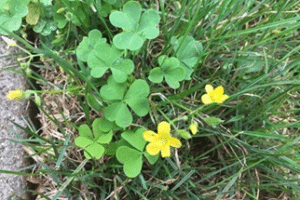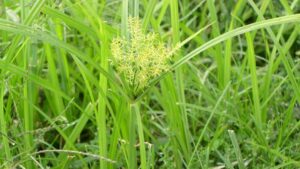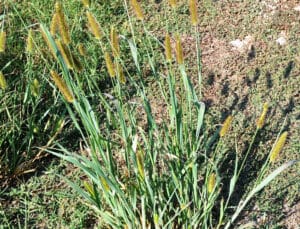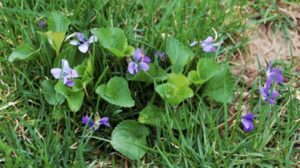Persicaria perfoliate
Description
Mile-a-minute (Persicaria perfoliata) is a trailing vine with barbed stems and triangular leaves. In contrast to other invasive vines, mile-a-minute is an herbaceous annual, meaning it dies each fall and new plants grow from germinating seeds in the spring. Originally from India and East Asia, this species was first reported in York County, Pennsylvania, in the 1930s in contaminated nursery soil. Mile-a-minute is listed as a “Class B” noxious weed by the State of Pennsylvania, a designation that restricts sale and acknowledges a widespread infestation that cannot feasibly be eradicated. The dense foliage of this invasive weed blankets and slowly suffocates native vegetation, making it extremely destructive and persistent despite being an annual plant.
Size: Each vine can grow 20 to 30 feet long, forming a dense, tangled blanket of intertwined vines. In the peak growing season, mile-a-minute can put on up to 6 inches of growth a day.
Leaves: Its leaves are distinctly triangular or arrowhead-shaped, 1 to 3 inches wide, vibrant green, and bear many hooked barbs along the underside of the central vein and leaf stem, or petiole. Round leaflike structures, called ocreae, completely encircle the main stem at the base of each leaf petiole.
Left: Triangular leaves and round leaflike structures, called ocreae. Right: Unripe (green) and ripe (blue) fruit; also showing cuplike leaf structure.
Fruit: While the pale green flowers are not noticeable, this vine produces metallic blue or purple berrylike fruit in late summer, each ¼ inch across. The fruit appear in an elongated cluster at the vine’s tips. The clusters have a round, cuplike leaf structure directly below them.
Stems: Stems are thin, flexible, and covered in tiny hooked barbs. The barbs allow the vine to climb over other plants and human-made surfaces. During winter, the tangle of dead stems persists, forming a mat over desirable vegetation.
Dispersal
The seeds are small and often distributed by accidental movement. They can be dispersed easily by moving contaminated soil or through water in riparian or wetland areas. The fruit is buoyant for up to nine days and can be deposited far downstream from parent colonies. Seeds can also be transported in contaminated soil found on heavy machinery and logging equipment. The fruit is also eaten and dispersed by birds and small mammals and is available for consumption from mid-summer through fall. Mile-a-minute seed can remain viable for at least six years, making eradication difficult.
Site
Mile-a-minute prefers sites with moderate to high soil moisture and full sunlight. As such, it is a rapid colonizer of forest edges, wetlands, roadsides, and streambanks. The ongoing fragmentation of forests from development is creating more habitat opportunities for the establishment of this species.
Cultural Control
Limited infestations of mile-a-minute can be pulled easily; take care to protect yourself from the sharp barbs by wearing a long-sleeved shirt and leather gloves. Before June, when the seed begins to mature, mile-a-minute can be pulled and left on site to dry. After seed emergence, pulled plants bearing fruit should be bagged and destroyed, as the fruit may continue to ripen. Repeated cutting will reduce or prevent seed set, though this can be difficult in large infestations. Ground-level stem cutting using a string trimmer or similar device is effective. If some stem nodes remain after cutting, the vine will likely regrow.
A biological control agent that feeds solely on mile-a-minute exists, the mile-a-minute weevil (Rhinoncomimus latipes). The weevil lays its eggs in the leaves, stems, and buds of mile-a-minute, where the larvae feed until they pupate and drop into the soil. The insect’s life cycle spans about one month, with several generations taking place over one growing season. Weevil infestation does not eradicate mile-a-minute. However, it does severely stunt the plant’s growth. While sale of the weevil is regulated by USDA APHIS, it is legal to distribute infected plant material to new sites within the same state.
Preemergence herbicides prevent seeds from germinating, and several are effective against mile-a-minute. Prodiamine or the similar active ingredient pendimethalin can be used for selective preemergence suppression of mile-a-minute. These herbicides only affect germinating seedlings and do not injure established vegetation. To be effective, preemergence herbicides must already be present in the soil at the time of germination and therefore should be applied at least two to three weeks prior to expected germination. Application timing is a challenge, as germination is based on soil temperature, which varies from year to year. A general guideline is to apply preemergence herbicides by mid-March (or late February in the event of an early spring).
To make this application more flexible, add a low rate of imazapic or sulfometuron to the mixture. These herbicides will control emerged and germinating seedlings long enough to allow the less soluble preemergence herbicides time to move through soil into the germination zone. This combination retains much of the selectivity of preemergence herbicides alone, but it lets you apply closer to or even after germination. Additionally, these combinations are also effective against Japanese stiltgrass (Microstegium vimineum), which commonly occurs on the same sites as mile-a-minute.
Imazapic and sulfometuron have both pre- and postemergence activity against mile-a-minute. Both products control grasses as well as herbaceous broadleaf vegetation. Sulfometuron poses little risk to hardwood and conifer seedlings and can be applied directly over the top of existing woody vegetation except during periods of active new growth in the spring. Many native warm-season grasses, wildflowers, legumes, and woody plants are tolerant of imazapic. Be sure to check the herbicide label for specific species efficacy and rates.
Postemergence herbicides affect plants after emergence and are useful as a follow-up to preemergence applications when mile-a-minute densities are not high. Where mile-a-minute is growing among desirable grasses, it can be selectively controlled using water-based formulations of triclopyr. Triclopyr controls broadleaved plants, leaving grasses and grasslike plants largely intact. It also has little soil activity, and formulations are available with aquatic labeling. Where mile-a-minute is growing in mixed vegetation and a selective mixture is not an advantage, a solution of glyphosate plus triclopyr can be applied with a backpack sprayer as a spot treatment. The advantage of this mix is that you can treat any invasive targets you encounter during your operation.
Due to its extended seed viability, it is unlikely you can eradicate mile-a-minute from a site, even with repeated effort. An alternate approach is investing effort in suppressing mile-a-minute long enough to release desired native vegetation to shade out mile-a-minute, with trees being the best option for a long-term shading approach. Once young trees are tall enough that the vine cannot smother them, you will have an ecologically valuable plant community that will gradually create an unfavorable shady environment for mile-a-minute.t removal of isolated individuals must be a part of any long-term invasive plant control program.





